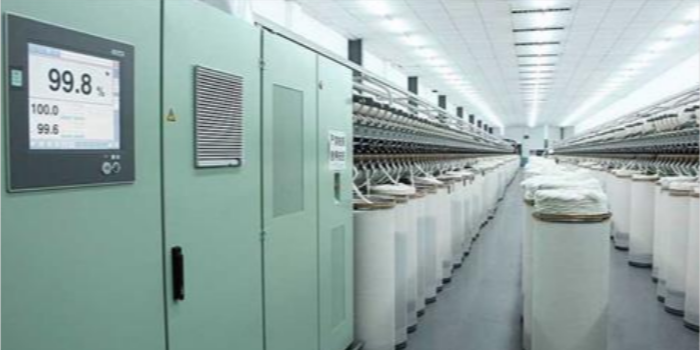
Ring and Rotor Spinning of Recycled Fibres
With one per cent of garments being recycled and three quarters of the world’s clothing ending up in landfill, the textile industry is seeking ways to make production more sustainable and pay more attention to the entire life cycle of clothing.
With
barely one per cent of garments being recycled and three quarters of the
world’s clothing ending up in landfill, the textile industry is actively
seeking ways to make production patterns more sustainable and pay more
attention to the entire life cycle of items of clothing. Rieter is offering
solutions for the integration of recycled raw material into yarn production to
help close the textile loop. The results of our latest study show that it is
possible to spin not only rotor, but also ring yarns of different quality with a
considerable amount of recycled raw material on a Rieter system.
In
recent years, better use of raw materials has become very important in the
textile sector due to growing environmental awareness, legal requirements for
more sustainability, and the cost of raw materials. As a result, more research
and development is being carried out in the various areas of textile recycling.
Coordination
and cooperation between the different industrial sectors, from the procurement
of raw materials through to the new final product, will be vital. Only then
will it be possible to expand and optimise the entire recycling process to help
it grow into a larger market. In the next few years, the realistic market
potential for the staple fibre industry for recycled raw materials amounts to
around 7.6 million tons annually if the current trend continues.
Classify the raw material
To
help spinners in the area of recycled fibres, Rieter has established a
classification system for the typical recycled raw material quality available
on the market (Fig. 1). The Rieter Recycling Classification makes it easier for
spinners to estimate what targets can be reached depending on the material. The
short-fibre content, the mean fibre length and the 5 per cent fibre length are
important parameters after the tearing process because they help to determine
which subsequent spinning process (ring or rotor) should be used and which
quality (uniformity) and maximum spinning fineness (yarn count) can be
achieved.
Defining the optimal spinning process
for recycled materials
A
very interesting recycling example is the re-spinning of used cotton clothes,
e.g. T-shirts. Typically, the recycled raw material is blended with virgin
cotton. This application was also used in the Rieter trial to determine the optimum
spinning process. Both the requirements for raw-material preparation and the best
machine configuration for spinning staple fibres were considered. The raw
material in the trial was a blend of virgin cotton from Chad and bleached
cotton recycled fibres which were mixed in varying proportions. The graphic
below shows the process sequences within the spinning process (Fig. 2).
Rotor yarn has the best unevenness
In essence, the rotor spinning machine is well suited for
processing fibres with a high short-fibre content (> 30%), which is
reflected in better evenness (Fig. 3). This is due to better fibre feeding of
the opened fibres in the closed fibre feed channel and the doubling of the
individual fibres in the rotor groove. For acceptable yarn quality and
operational reliability, a blend containing up to 75 per cent recycled content
is possible in this raw material configuration.
Ring yarn has the highest tenacity
Ring
yarn, by contrast, has the highest yarn tenacity on account of more intensive fibre
integration (Fig. 4). This opens a wider range of applications, namely the
increased use of these yarns in weaving mills. Tenacity reduces as the recycled
and short-fibre content increases.
Is it economical to produce yarn from
recycled fibres?
The
economic efficiency depends on the proportion of recycled material in the yarn,
as this has an influence on the yarn conversion costs and the yarn sale price. In
the Rieter trial a yarn count between Ne 12 and Ne 20 was
used and the yarn conversion costs were calculated for ring yarns and rotor
yarns in Turkey (Fig. 5).
The
economic analysis assumes a slightly cheaper recycled raw material price
compared to a medium-quality virgin cotton. The calculation is also based on
the realistic view that trade will accept a higher price for yarn made of
recycled fibres. Depending on the amount of recycled fibres there is little
loss of yarn or fabric quality, but raw material resources are better utilized
and meet the need of many companies to become more sustainable. A blend
containing 25 to 50 per cent recycled raw material should therefore achieve a
yarn sales price which is at least 0.1 to 0.2 cents per kg higher than
that of virgin cotton raw material, depending on the end-spinning process and
yarn count. Graphic 5 shows that the Return on Investment (ROI) is best for
blends containing 25 to 50 per cent recycled material.
There
will be greater or lesser scope for the economic viability of the staple-fibre
yarn production process depending on whether it is a case of yarn trading or a
fully integrated process. In any case, the economic analysis shows interesting
opportunities for processing recycled cotton raw materials using staple-fibre
yarn production.
Detailed
information on spinning recycled fibres can be found here:
https://www.rieter.com/products/spinning-systems/recycling-spinning-system




